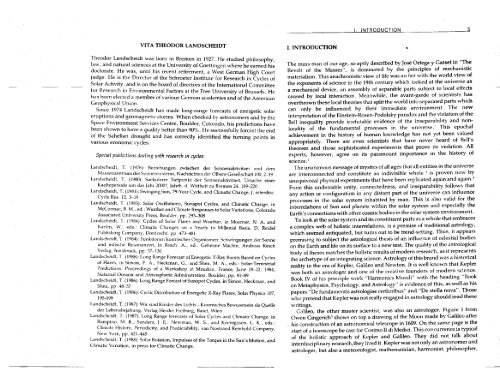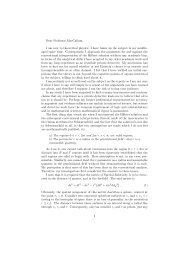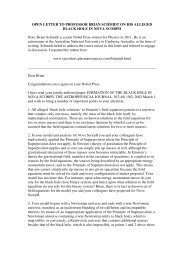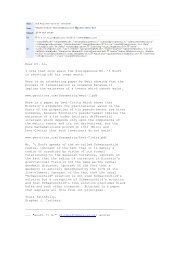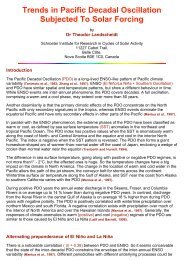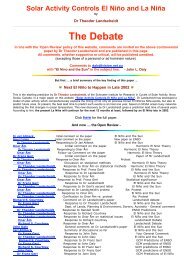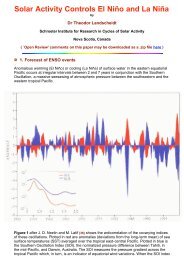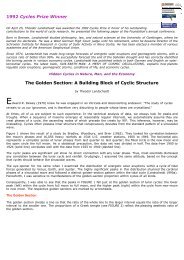Sun-Earth-Man - PlasmaResources
Sun-Earth-Man - PlasmaResources
Sun-Earth-Man - PlasmaResources
Create successful ePaper yourself
Turn your PDF publications into a flip-book with our unique Google optimized e-Paper software.
--<br />
VITA THEODOR LANDSCHEIDT<br />
Theodor Landscheidt was born in Bremen in 1927. He studied philosophy,<br />
law, and natural sciences at the University of Goettingen where he earned his<br />
doctorate. He was, until his recent retirement, a West German High Court<br />
judge. He is the Director of the Schroeter Institute for Research in Cycles of<br />
Solar Activity, and is on the board of directors of the International Committee<br />
for Itesearch in Environmental Factors at the Free University of Brussels. He<br />
has been elected a member of various German academies and of the American<br />
Geophysical Union.<br />
Since 1974 Landscheidt has made long-range forecasts of energetic solar<br />
eruptions and geomagnetic storms. When checked by astronomers and by the<br />
Space Environment Services Centre, Boulder, Colorado, his predictions have<br />
been shown to have a quality better than 90%. He successfuIly forcast the end<br />
of the Sahelian drought and has correctly identified the turning points in<br />
various economic cycles.<br />
Special publictions dealing with research in cycles:<br />
Landscheidt, T. (1976): Beziehungen zwischen der Sonnenaktivitaet und dem<br />
Mc~sscnzenh~um des <strong>Sun</strong>nensvstems, Nachrichten der Olbers-Gesellschaft 100,Z-19<br />
Landscheidt, 7'. (1980): Saekularer Tiefpunkt der Sonnenaktivitaet, Ursache einer<br />
Kaelteperiode um das Jahr 2000?, lahrb. d. Wittheit zu Bremen 24. . 189-220 - ---<br />
Landscheidt, T. (1981): Swinging <strong>Sun</strong>, 79-Year Cycle, and Climatic Change, I. interdisc.<br />
Cycle Res. 12, 3-19<br />
Landscheidt, T. (1983): Solar Oscillations, <strong>Sun</strong>spot Cycles, and Climatic Change, in<br />
McCormac, B. M.. ed. : Weather and Climate Responses to Solar Varia tions, Colorado<br />
Associated University Press, Boulder, pp. 295308<br />
Landscheidt, T. (1984): Cycles of Solar Flares and Weather, in Moerner, N. A. and<br />
KarlCn, W., eds.: Climatic Changrs on a Yearly to Millenial Basis, D. Reidel<br />
Publishing Company, Dordrecht, pp. 47H81<br />
Landscheidt, T. (1954): Funktioncn kosmischer Organismen: Schwingungen der Sonne<br />
und irdische Rcsonanzen, in Resch, A., ed.: Geheime Miichte, Andreas Resch<br />
VerIag, Innshruck, pp. 37-130<br />
Landscheidt. T (1986): Long Range Forecast of Energetic X-Ray Bursts Based on Cycles<br />
of Flares, in Simon, P A., Heckman, G., and Shea, M. A,, eds.: Solar-Terrestrial<br />
Predictions: Proceedings of a Workshop at Meudon, France, June 18-22, 1984,<br />
National Oceanic and Atmospheric Adminstration, Boulder, pp. 81439<br />
Landscheidt, T. (1986): Long Range Forcast of <strong>Sun</strong>spot Cycles, in Simon, Heckman, and<br />
. .<br />
Shea, pu. W 57<br />
Landscheidt, T. (1986): Cyclic Distribution of Energetic X-Ray Flares, Solar Physics 107,<br />
195-199<br />
I.andscheidt, T (1987): Wir sind Klndcr des Lichts- Kosrnisches Bewusstsein als Quelle<br />
der Lebenshejahung, Verlag Herder Fretburg, Basel, Wien<br />
Landscherdt, 7'. (1987): Long Range forecasts of Solar Cycles and Climatic Change, in<br />
Rampino, M. K., Sanders, J. E., Newman, W. S., and Koenigsson, L. K., eds.:<br />
Chmate History, Periodic~ty. and Predictability, van Nostrand Reinhold Company,<br />
New York, pp. 421445<br />
Landscheidt, T. (1988): Solar Rotation, Impulses of the Torque in the <strong>Sun</strong>'s Motion, and<br />
Climatic Variation, in press for Climatic Change.<br />
I. INTRODUCTION<br />
1. INTRODUCTION 5<br />
The mass-man of our age, so aptly described by Jose mega y Gasset in "The<br />
Revolt of the Masses", is dominated by the principles of mechanistic<br />
materialism. This anachronistic view of life was au fait with the world view of<br />
the exponents of science in the 19th century which looked at the universe as<br />
a mechanical device, an assembly of separable parts subject to local effects<br />
caused by local interaction. Meanwhile, the avant-garde of scientists has<br />
overthrown these local theories that split the world into separated parts which<br />
can only be influenced by their immediate environment. The new<br />
interpretation of the Einstein-Rosen-Podolsky paradox and the violation of the<br />
Bell inequality provide irrefutable evidence of the inseparability and non-<br />
locality of the fundamental processes in the universe.' This epochal<br />
achievement in the history of human knowledge has not yet been valued<br />
appropriately. There are even scientists that have never heard of Bell's<br />
theorem and those sophisticated experiments that prove its violation. All<br />
experts, however, agree on its paramount importance in the history of<br />
science.'<br />
The unanimous message of mystics of allages that allentities in the universe<br />
are interconnected and constitute an indivisible whole ' is proven now by<br />
unequivocal physical experiments that have been replicated again and again.'<br />
From this undeniable unity, connectedness, and inseparability follows that<br />
any action or configuration in any distant part of the universe can influence<br />
processes in the solar system inhabited by man. This is also valid for the<br />
interrelations of <strong>Sun</strong> and planets within the solar system and especially the<br />
<strong>Earth</strong>'s connections with other cosmic bodies in the solar system environment.<br />
To look at the solar system and its constituent parts as a whole that embraces<br />
a complex web of holistic interrelations, is a premise of traditional astrology,<br />
which seemed antiquated, but turns out to be trend-setting. Thus, it appears<br />
promising to subject the astrological thesis of an influence of celestial bodies<br />
on the <strong>Earth</strong> and life on its surface to a new test. The quality of the astrological<br />
body of theses matches the holistic results of modem research, as it represents<br />
the archetype of an integrating science. Astrology of this brand was a historical<br />
reality in the era of Kepler, Galileo and Newton. It is well known that Kepler<br />
was both an astrologer and one of the creative founders of modern science.<br />
Book IV of his principle work "Harmonics Mundi" with the heading "Book<br />
on Metaphysics, Psychology, and Astrology" is evidence of this, as well as his<br />
papers "De fundamentis astrologiae certioribus" and "De stella nova". Those<br />
who pretend that Kepler was not really engaged in astrology should read these<br />
writings.<br />
Galileo, the other master scientist, was also an astrologer. Figure 1 from<br />
Owen Gingerich5 shows on top a drawing of the Moon made by Galileo after<br />
his construction of an astronomical telescope in 1609. On the same page is the<br />
start of a horoscope he cast for Cosimo I1 di Medici. This concurrence is typical<br />
of the holistic approach of Kepler and Galileo. They did not talk about<br />
interdisciplinary research, they lived it. Kepler was not only an astronomer and<br />
astrologer, but also a meteorologist, mathematician, hamonist, philosopher,


